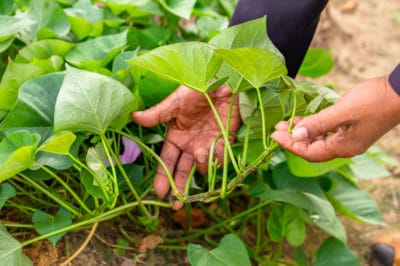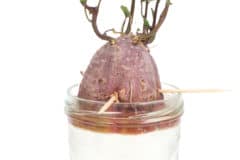What is a Sweet Potato?
The sweet potato, Ipomoea batatas, is a tropical perennial vine. It belongs to the Convolvulaceae family and is related to bindweed and morning glories. It is distantly related to nightshade, tomatoes and Irish potatoes. The plant produces edible, heart-shaped leaves on a long vine as well as edible tuberous roots in colors that include white, red, pink, orange, beige, brown and purple.
Are Sweet Potatoes Yams?
True yams are a very different plant, although both yams and sweet potatoes are tropical perennial vines and produce an edible tuber. The true yams – there are several cultivars – belong to the Dioscoreaceae family. They are native to Africa, Asia and the Americas, depending on the variety. Nigeria is the largest producer of true yams and they are an important food source in Africa.
Where Did Sweet Potatoes Come From?
Sweet potatoes were originally thought to have originated in South America. Peru, Mexico and the Yucatan Peninsula were also considered possible points of origin. Sweet potatoes were domesticated in South America as early as 5,000 years ago. However, a recent archeological discovery in India indicates that country may have been where sweet potatoes first developed.
Where are Sweet Potatoes Grown?
Sweet potatoes are best adapted to tropical and subtropical climates. As you might expect, they do best in warm, long-season climates such as those found in USDA Zone 8 or 9. They may become perennial in those zones. However, they can be grown in colder areas with extra attention. Mulching with black plastic mulch, for example, may increase soil warmth in a colder area.
What Sweet Potato Varieties Are Available?
Several dozen sweet potato varieties are available, although some are only found in a localized area. Here are some possibilities:
- Apache
- Brinkley White
- Centennial
- Cherokee
- Cordner (found in Texas)
- Hannah
- Hernandez (found in Louisiana)
- Jewell (found in North Carolina)
- White Delight (found in Georgia).
Do Sweet Potatoes Come in Different Colors?
Both the skin and the interior of a sweet potato can be colored. Possible skin colors include white, red, yellow, purple and brown. The interior can be yellow, white, orange, orange-red or purple. Some sweet potatoes have a solid-colored skin and the interior is white flecked with another color. Cooking can affect the color, changing a white interior to yellow, for example.
What’s the Best Soil for Sweet Potatoes?
Sweet potatoes will grow readily in nearly any soil, but they prefer loamy, well-drained soil. It should not be too rich, and these plants will even grow well in sandy soil. They will tolerate a pH of 5.0 but prefer a pH range of 5.8 to 6.0. They will grow in heavy clay but will do better if the soil is amended with humus or mixed with coarse sand to improve drainage.
Can I Grow Sweet Potatoes Indoors?
It’s easy to grow a sweet potato vine indoors in the same way you would grow an Irish potato in water, Place toothpicks into the sides of the sweet potato, put in a container of water and place in a sunny window. You can’t harvest tubers in this manner, however. If you have a greenhouse, you can grow sweet potatoes there in a container or garden bed.
Can I Grow Sweet Potatoes in a Cold Climate?
The answer to this question is a qualified maybe. To grow them outdoors, you will need to start them well ahead of time and grow in a greenhouse, then transplant to the garden when it’s warm enough. Use season-extending tricks like a black plastic mulch or grow in a hotbed for increased soil warmth. You’ll probably need to harvest earlier than you normally would.
Can I Grow Sweet Potatoes in the Shade?
Sweet potatoes are not truly shade-tolerant plants. However, they can be grown in areas where the garden is partly shaded as long as they get at least six hours of sun a day. They will probably not produce as luxuriant a vine as those grown in the sun. Sweet potatoes that are not grown in full sun typically produce smaller tubers and take longer to mature.
Can I Grow Sweet Potatoes in Containers?
Sweet potatoes need plenty of room for their root system and tubers. You need a large container – something like a trash can or whiskey barrel is a good choice. Make sure the container has plenty of drainage holes. Use a soil that drains well and place at least three inches of gravel in the bottom of the container. Place the container in full sun.
When Should I Plant Sweet Potatoes?
Sweet potatoes are very frost-sensitive. Equally important, they simply don’t grow well unless the soil and air are dependably warm. You should not plant them outdoors until about a month after the last spring frost. Unless you have a long growing season, it might be best to start your slips in a greenhouse and transplant once the weather is warm enough.
How Do I Water Sweet Potatoes?
Unlike their Irish “cousins,” sweet potatoes can be grown without irrigation in many areas. If the soil is well-watered before they are planted and then watered until the plants are well-established, they may grow just fine. However, irrigation can help assure a larger harvest and even soil moisture means tubers are less likely to have splits or fissures. In times of drought, the leaves may steal water from tubers.
Do Sweet Potatoes Need Fertilizer?
Sweet potatoes can be grown without fertilizer if your soil is reasonably fertile. However, they will produce much better with supplemental feeding. You can use a commercial slow-release fertilizer in granule form – work into the soil about two weeks after planting. You can also use liquid fertilizer on the soil or spray the leaves with a dilute form. Compost and mulch are also helpful.
What About Insect Pests?
Sweet potatoes have a number of insect enemies. The sweet potato weevil, found around the world, is probably the most serious pest. Some insects attack the leaves, while others attack the tubers. Common pests in almost all areas include grasshoppers, crickets, leafminers, aphids and whites. Other insect pests include whitegrubs, hawk moth larvae, wireworms and silverleaf whiteflies.
Can Sweet Potatoes Develop Diseases?
Rots and fungi are probably the biggest problems when it comes to sweet potato diseases. Some of these develop in the fields, while others occur in storage. The various diseases often attack the roots and are more likely to occur when sweet potatoes are grown in areas where the soil is flooded or remains constantly moist. Diseases include scurf, storage rot, scab and little leaf disease.
When Should I Harvest Sweet Potatoes?
Sweet potatoes can have a long harvest period. Once the tubers are big enough for a meal, you can start to harvest. This usually occurs about three or four months after you plant the slips. The main crop (and the largest tubers) are usually ready once the leaves and ends of the vines begin to turn yellow. However, you can actually leave the tubers in the ground until frost threatens.
Do Sweet Potatoes Need to Be Cured?
When first harvested, sweet potatoes really aren’t very sweet. They should be cured for about 10 days to two weeks. The ideal spot for curing is a room with a temperature of 85°F (29°C) and 85 percent humidity. Place the sweet potatoes in a single layer in plastic bags with holes punched in them. Tie or zip closed and place in a sunny windowsill for 10 days.
How Do I Store Sweet Potatoes?
Unlike Irish potatoes, sweet potatoes won’t last very long in storage. If you store them in a cool, dry, well-ventilated area, they may last for up to four weeks. Sweet potatoes can be boiled for a short period, then sliced and frozen. Mashed and baked sweet potatoes can also be frozen. In both cases, the vegetable will be good for up to a year. The tubers can also be canned or dehydrated and will store indefinitely.
How Can I Use Sweet Potatoes?
The classic sweet potato dish is often found on Thanksgiving tables. Sweet potatoes are baked or boiled, sliced and turned into a casserole with brown sugar and marshmallow topping. They can also be baked or boiled and eaten with butter. Sweet potatoes make good tempura and dehydrated chips are eaten as a snack food.












